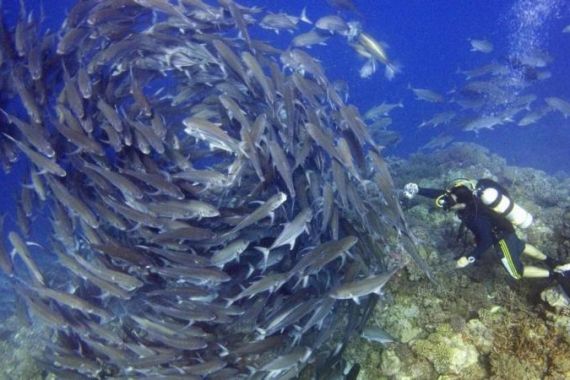Local control revives depleted fisheries
Small community-led no-fishing areas are protecting reefs and sustaining marine environments.

Cairns, Australia – It takes a village to protect a reef and sustain a local fishery, more than two decades of experience now shows.
And even well-intentioned governments can do more harm than good, community-based conservation experts reported here at the 12th International Coral Reef Symposium (ICRS).
Keep reading
list of 4 itemsCould shipping containers be the answer to Ghana’s housing crisis?
Thousands protest against over-tourism in Spain’s Canary Islands
Holding Up the Sky: Saving the Indigenous Yanomami tribe in Brazil’s Amazon
“The first locally managed marine areas doubled the fish biomass [amount and size of fish] in just a few years,” said Alan White, senior scientist with the Nature Conservancy at the Global Marine Initiative, Hawaii.
Locally managed areas (LMAs) were first set up in the 1980s in the Philippines. The local community established a no-fishing zone of just 15 hectares of coral reef, and in between three and four years the fish biomass doubled, White said. It was all done without government involvement.
“Once the community sees the benefits, they continue and the idea spreads,” he said.
There’s been too much top-down management of fisheries by governments, said Helene Marsh, professor of environmental science and dean of graduate research studies at James Cook University. Even in Australia, fishers want more local management and to be directly involved, Marsh said.
“Before LMAs began in the 1980s, fish catches were in sharp decline and desperate fishers were using dynamite to catch the last remaining fish,” said Jovelyn Cleofe, the Philipines country coordinator for the Locally Managed Marine Area Network.
Now there are more than 1,000 LMAs in the Philippines. The no-fish areas are quite small – between ten and 20ha each – but numbers of fish have increased, the diversity of fish species has doubled, and the health of the corals improved.
Equally important, fishers’ incomes have risen, because they are catching more fish with less effort. And in some cases they earning additional money from tourism, Cleofe said.
Now the latest science has proven that protected areas “seed” the surrounding seas with additional fish. When fish eggs hatch, the microscopic fish larvae drift on the ocean currents which made it extremely difficult to know where they will end up, explained Geoff Jones, of the ARC Centre of Excellence for Coral Reef Studies at James Cook University.
Jones and colleagues took DNA fingerprints of thousands of adult fish inside protected areas in Australia’s Great Barrier Reef. Then they went looking for baby fish in the areas where fishing was allowed and tried to match up their DNA with the adult fish in an attempt to establish parental lineage. The researchers found far more matches than expected – 70 per cent in some areas – meaning that most baby fish had come from the protected areas.
| When control and decisions are at the community level they are more likely to consider the needs of future generations of people. |
“We now have proof that at least 50 per cent of the baby fish – including some as far as 20 kilometres away – came from protected areas,” Jones said.
LMAs are a great strategy and the concept has expanded rapidly, said Stacy Jupiter, Fiji country programme director for the Wildlife Conservation Society: “Science also tells us that it is the big fish that lay the most eggs.”
In Fiji, even where there’s extensive coastal development such as hotels, corals and fish inside LMAs are doing well, whereas those in other areas are not, she said. However, this only works when the communities have full control over the access to their fishing grounds and to the reefs. It’s also important that everyone complies with the rules.
When control and decisions are at the community level they are more likely to consider the needs of future generations of people, said Andrew Wayne, a member of the Palau National Congress and chair of Protected Areas. Palau is a nation of 20,000 people spread over a chain of islands in the western Pacific.
Where control is held entirely by the government as in the island Guam, the reefs are overfished and in decline, Wayne explained.
“It is important that everyone in the community and their neighbours are informed about the rules of the LMA. There also needs to be effective enforcement,” he said.
Peer pressure and respect for rules are crucial. So is education. “We are working with children to teach them to love their reefs and that will make things easier in the future,” Wayne said.
Palau’s traditional chiefs have often declared a “bul”, or ban, on fishing in an area when they noticed fish declines. There is still respect for this, but it is in conflict with Palau’s modern democracy, he said. Unfortunately, there is also a growing Western tendency to focus on how a resource can benefit an individual versus the entire community, including future generations.
Wayne concluded: “If the local community feels they own the resource and will always own it, it makes all the difference.”
A version of this article first appeared on IPS.